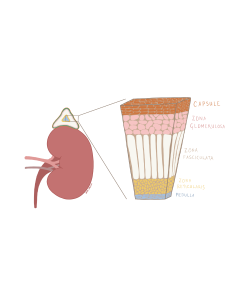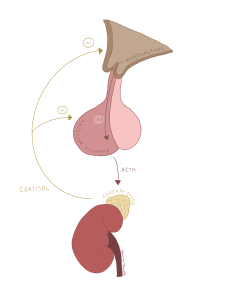18 Adrenal Glands
Adrenal Gland:
If you’ve ever faced extreme stress, such as during a race or while rushing to a meeting, you’ve felt the effects of your adrenal glands in action. The adrenal glands sit atop the kidneys and are responsible for regulating several functions, including the stress response.
The adrenal gland can be divided into zones based on the hormones they release.
Table 19 Adrenal gland zones and their associated hormones
| Adrenal gland zones | Function |
| Zona glomerulosa | Releases hormones called mineralocorticoids which regulate salt and mineral balance, (e.g., aldosterone (ALD)) |
| Zona fasciculata | Releases hormones called glucocorticoids which regulate glucose metabolism (e.g., cortisol) |
| Zona reitcularis | Releases androgens (hormones that stimulate sexual and reproductive functions) like estrogen or testosterone |
| Adrenal medulla | Releases stress hormones like epinephrine and norepinephrine which serve to increase blood pressure, alertness |

Figure 34 Adrenal gland anatomical segments
To remember these functions, think: “Sweet, Salty, Sex”
Table 20 Functions of hormones
| Class of Hormones | “Sweet, Salty, or Sex” | Function |
| Glucocorticoids (e.g. cortisol) | Sweet | Involved in glucose metabolism |
| Mineralocorticoids (e.g. aldosterone) | Salty | Help regulate salt and water balance |
| Androgens (e.g. DHEA or estrogen) | Sex | Involved in development of secondary sexual characteristics |
Hormone Regulation:
The hormones of the adrenal cortex are regulated by the hypothalamus and pituitary gland, primarily through negative feedback loops.
Think back to the last time you woke up feeling well rested and alert, ready to start your day. At that moment, your cortisol levels were likely elevated, exceeding their typical homeostatic concentration. To restore balance, the elevated cortisol levels signaled the hypothalamus and anterior pituitary to decrease their release of CRH and ACTH respectively. This feedback mechanism helped bring cortisol levels back to their normal range, maintaining homeostasis.

Figure 35 Negative feedback loop of cortisol
Adrenal Blood Supply:
Although the adrenal glands are tiny and only weigh about 5 grams, they receive a significant blood supply. Blood comes to them from the suprarenal arteries.
When looking at the blood supply, you’ll see that the adrenal glands are highly vascularized and have a lot of veins too. The suprarenal veins drain the adrenal glands. On the left side, the vein drains into the left renal vein, while on the right side, it drains directly into the renal vein.
These glands are a lot larger in the fetus, but they quickly shrink after birth since the fetal cortex degenerates.
Do you understand this meme about the adrenal glands?

Hint: The adrenal glands are multipurpose and hardworking, evidenced by the range of functions that Gru is describing. However, he seems upset that most people don’t appreciate all this about the adrenal glands! Click here for a refresher on the secretions of the adrenal glands.

